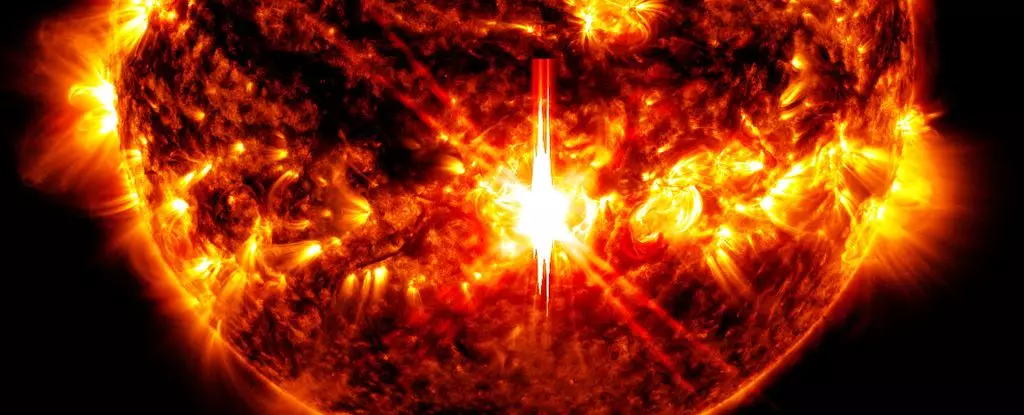On October 3, 2024, the astronomical community witnessed a spectacular display of solar activity when the Sun unleashed its most potent flare in recent years, measuring an astonishing X9.0. This event marks the second significant X-class flare to erupt from the same active sunspot, AR 3842, within the first few days of October. The last time scientists recorded such intense solar activity was in September 2017, when an even more powerful flare peaked at X11.88. The prominence of these flares highlights an ongoing trend, as the Sun is currently in the peak phase of its 11-year solar cycle. Since early 2022, solar flares have become a common sight as the Sun’s activity escalates.
The eruption of such flares raises several important discussions around solar phenomena and their implications on Earth. This story emphasizes not only the raw power of the Sun but also the complex interactions of magnetic fields that govern solar activity.
Flares are not merely random explosions; they stem from sunspots—intense areas on the Sun’s surface where magnetic fields become particularly pronounced. The classification of AR 3842 as a ‘Beta-Gamma-Delta’ sunspot region speaks to its intricate and dynamic magnetic structure. Each aspect of this classification plays a role in the frequency and intensity of solar flare activity. The Beta-Gamma classification indicates that opposing magnetic fields are present, while the Delta classification suggests a higher probability of explosive activity due to the concentrated oppositional polarities.
On October 1, prior to the X9.0 explosion, AR 3842 produced an X7.1 flare, establishing a concerning pattern of heightened activity. Such rapidfire releases of energy reveal the chaotic dance of magnetic fields in these sunspot regions, where tension builds until it’s suddenly released in a solar flare. This chain reaction points to a continually evolving dynamic at play—a reminder of how little control we have over the Sun’s natural rhythms.
Solar flares often serve as precursors to coronal mass ejections (CMEs)—massive bursts of solar wind and magnetic fields rising above the solar corona. A halo CME, like the one that accompanied the X9.0 flare, is particularly significant because it is directed toward Earth, meaning we are set to experience its effects directly. CMEs can travel across the expanse of space in a matter of days, interacting with Earth’s magnetosphere to instigate geomagnetic storms.
While the immediate threat to human life from flares is minimized—the high-energy radiation cannot penetrate the Earth’s atmosphere—secondary effects such as radio communication disruptions are compelling concerns for those in affected areas. Satellite operations and GPS services can experience interference as these solar particles collide with Earth’s protective magnetic field, creating electrical currents in the upper atmosphere.
Moderate to severe geomagnetic storms can lead to voltage surges in power grids and pose heightened risks to satellites. As happened with the recent X-class flares, these waves of solar particles can also produce stunning auroras, leading to increased interest in skywatching activities.
Auroras are nature’s own light show, resulting from solar particles colliding with the atmospheric gases, creating an iridescent display of colors. By interacting with the Earth’s magnetic field, these particles are energized, resulting in glowing waves that vary depending on the elements present in the atmosphere. The anticipated conditions resulting from the powerful flares and accompanying CMEs are expected to yield not just minor auroras, but potentially substantial displays visible as far south as 50 degrees latitude.
This October’s flares come on the heels of a surge in solar activity following a period of calm. The NOAA is already forecasting several days of peak aurora conditions, inviting people to take this opportunity for celestial exploration.
The record-breaking solar activity of October 2024 serves as a poignant reminder of our own vulnerabilities in the face of cosmic forces. While we are safe on the surface, the interference with technology and daily life challenges us to understand and adapt to solar phenomena. The Earth operates under the influence of a dynamic system, balancing the awe of its beauty with the necessity of vigilance. As we prepare for the potential visual delights of auroras, we must also remain mindful of the technical ramifications posed by solar events—encouraging a dual respect for both the elegance and the chaos of our neighboring star. In this cosmic interplay of beauty and threat, humanity continues to embrace the unknown.


Leave a Reply